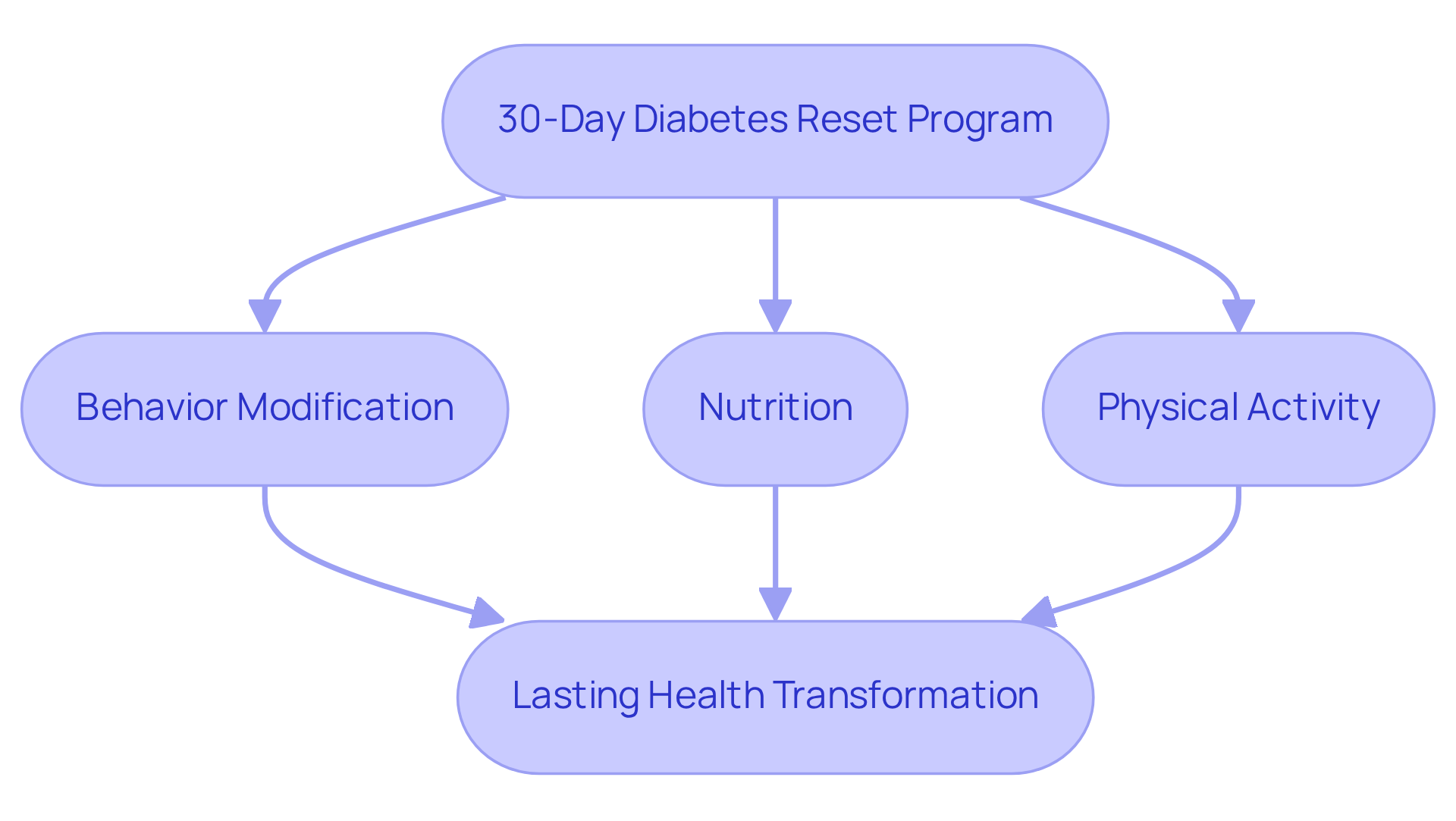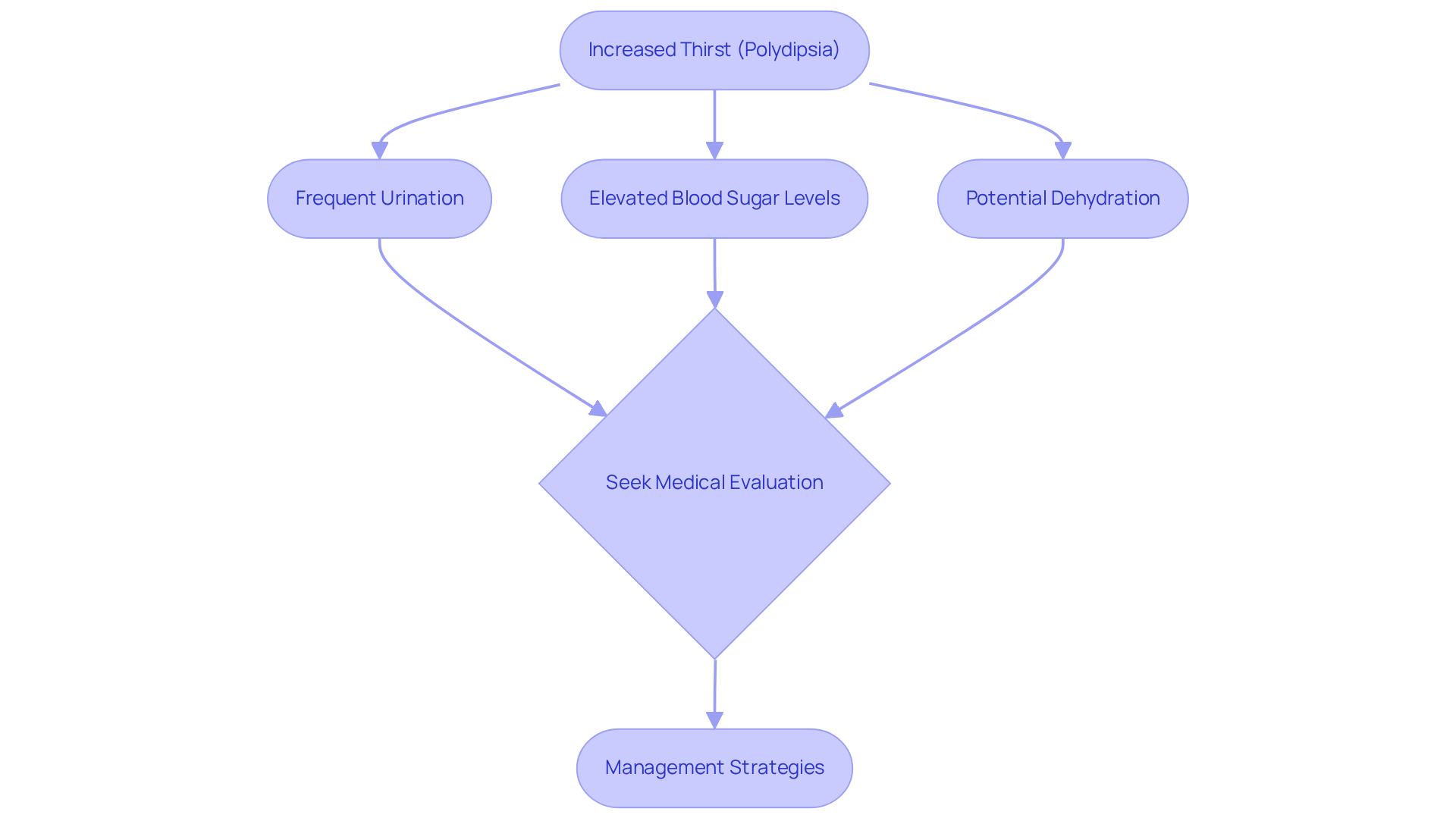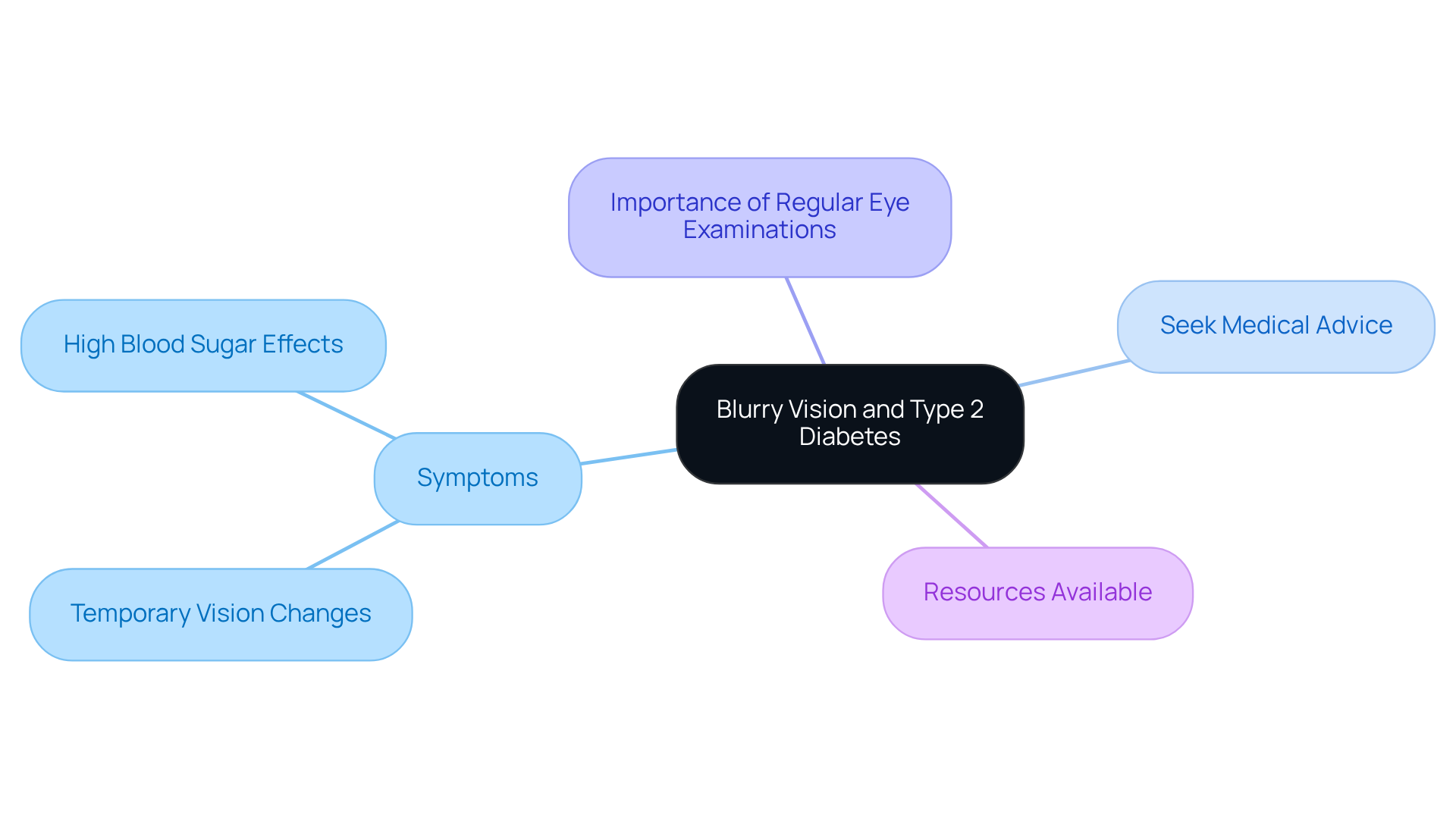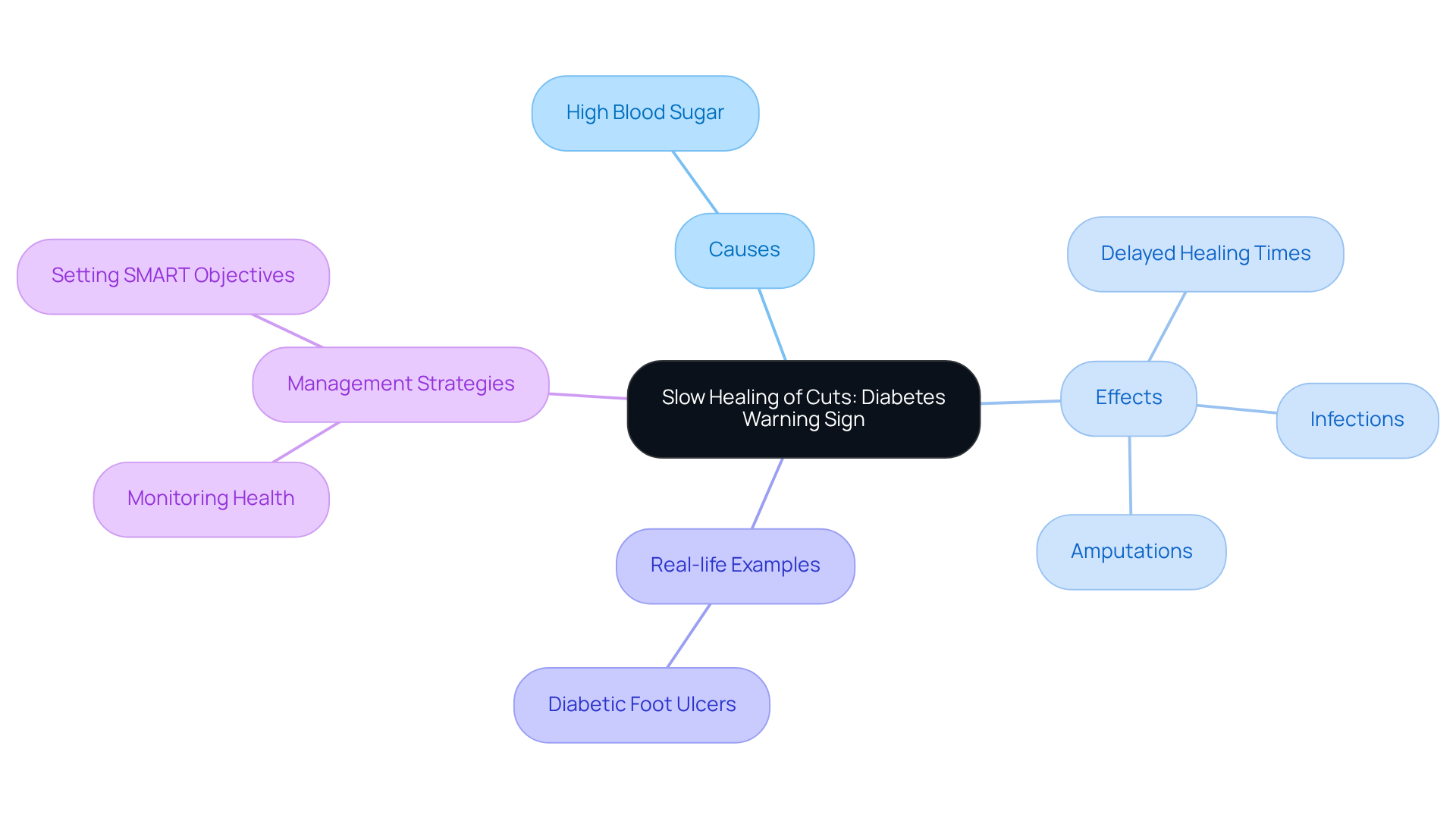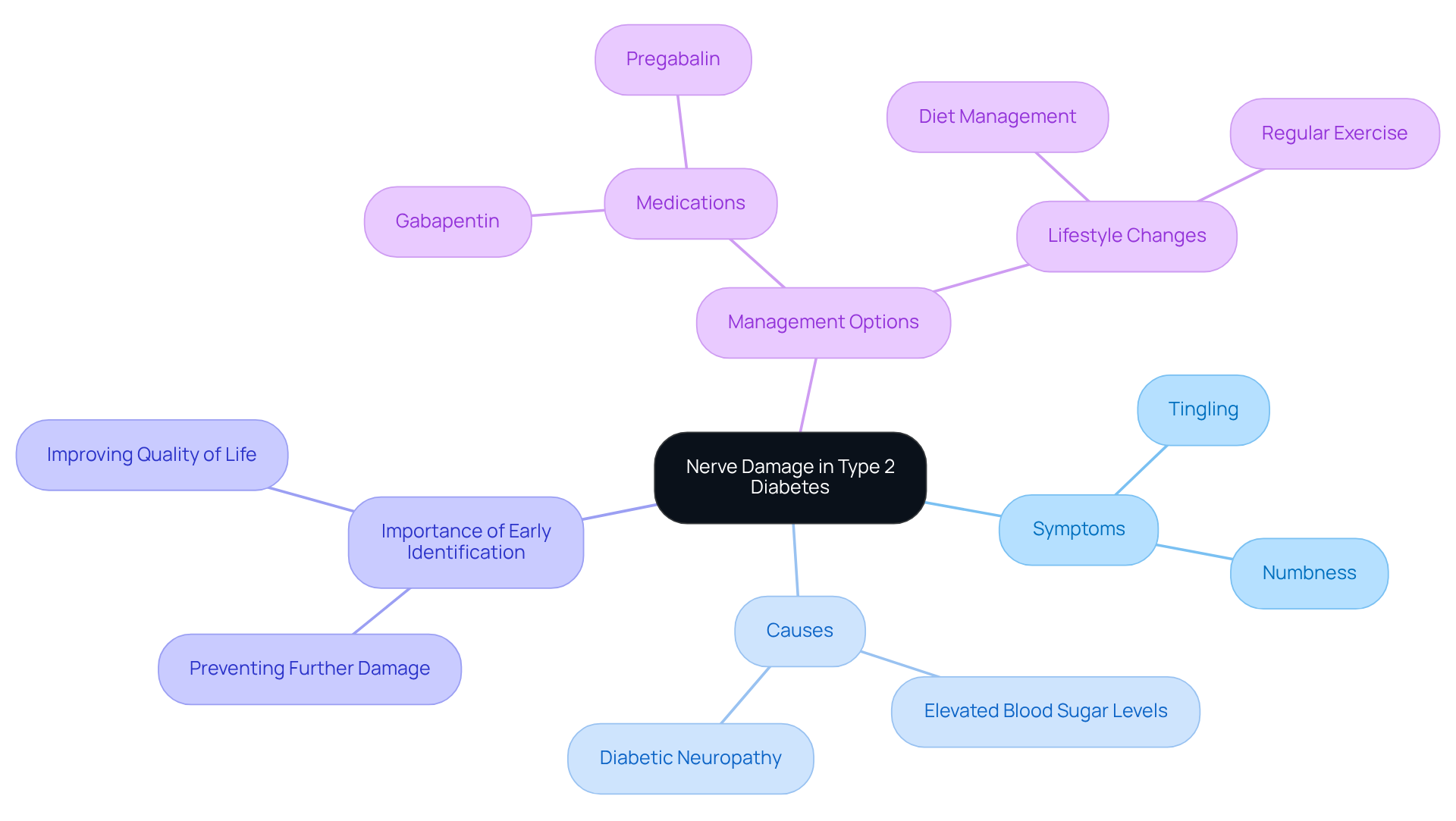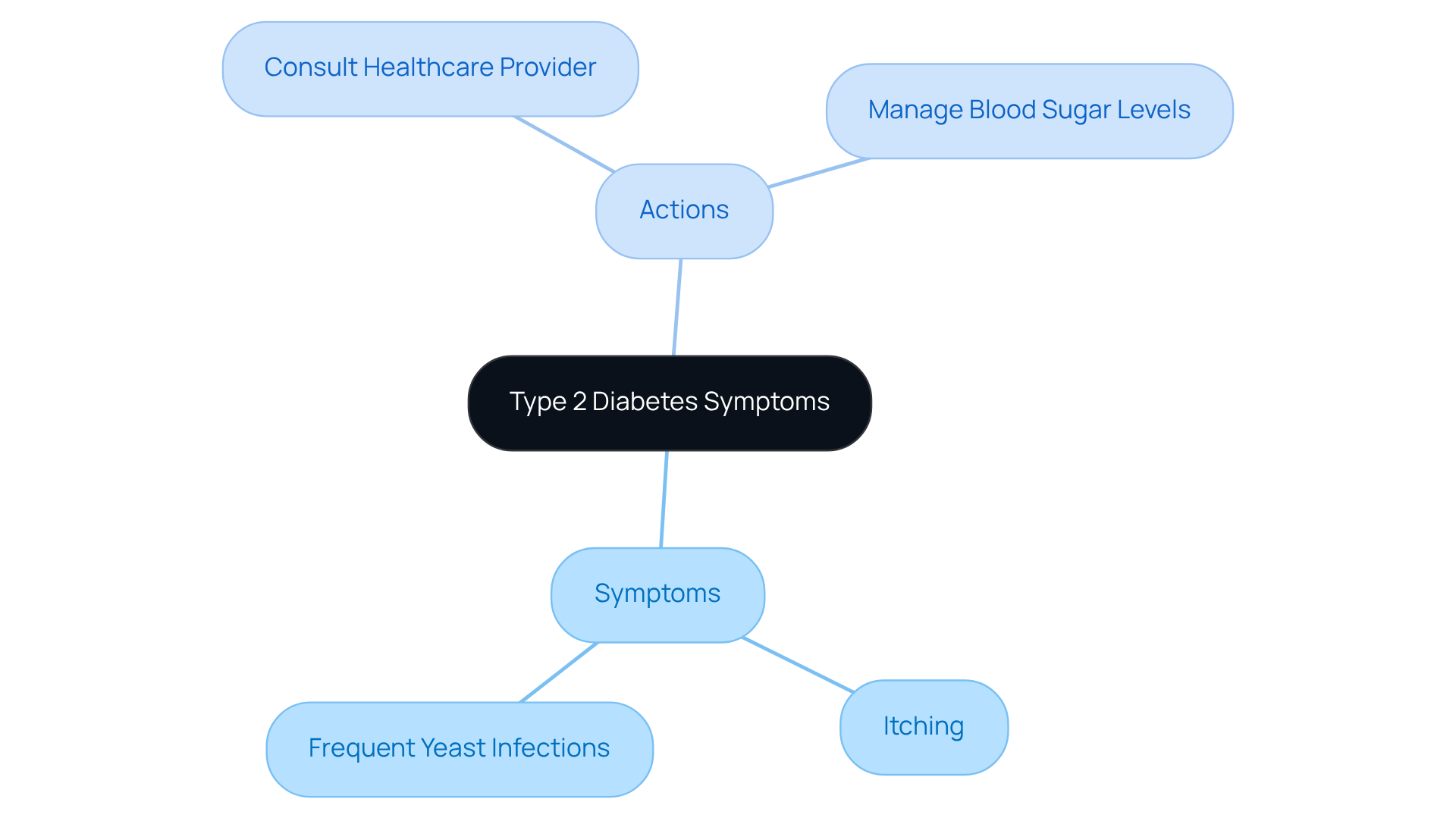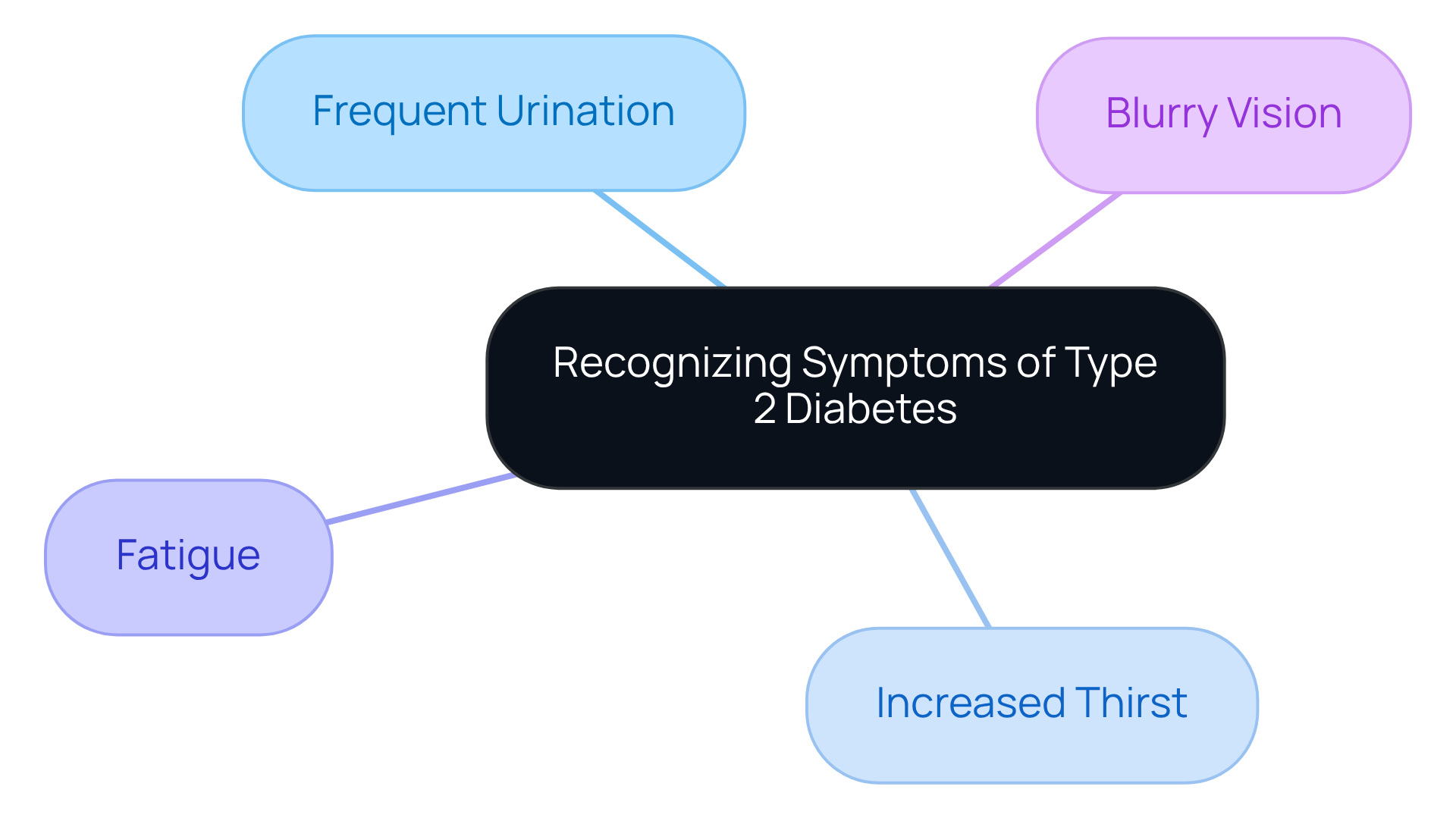Overview
If you or someone you know is experiencing symptoms like frequent urination, increased thirst, fatigue, blurry vision, slow healing of cuts, tingling or numbness, patches of darker skin, or persistent itching and yeast infections, it’s important to take notice. These signs can be distressing and may indicate type 2 diabetes. Recognizing these symptoms is crucial, as early diagnosis can lead to effective management and prevent serious health complications.
Many individuals find themselves overwhelmed by these symptoms, feeling uncertain about what they mean for their health. It’s understandable to have concerns, but acknowledging these signs is the first step toward taking control. Remember, you are not alone in this journey. Support is available, and by addressing these symptoms, you can work towards a healthier future.
Taking action now can make a significant difference in your well-being. Consider exploring programs like the 30-Day Diabetes Reset, which can guide you toward healthier living and empower you to manage your health effectively.
Introduction
Recognizing the signs of type 2 diabetes is vital for timely intervention and effective management. With nearly 34% of Americans affected by obesity and many remaining unaware of their condition, understanding these warning signs can empower individuals to take control of their health. It’s important to recognize that these symptoms can be subtle yet significant.
What are the key symptoms that should never be overlooked, and how can early recognition lead to improved health outcomes? This article delves into nine critical signs of type 2 diabetes, illuminating the importance of awareness and proactive care. By acknowledging these signs, you can take the first step toward a healthier future.
Integrative Wellness Center: 30-Day Diabetes Reset Program for Lasting Health Transformation
Are you struggling with the signs of diabetes type 2 and feeling overwhelmed by your condition? The 30-Day Diabetes Reset Program at the Integrative Wellness Center is here to offer you a compassionate solution. This pioneering initiative is designed to transform your health and empower you with the essential tools and knowledge to manage your blood sugar effectively.
Imagine personalized coaching sessions that focus on:
- Behavior modification
- Nutrition
- Physical activity
These sessions foster sustainable habits that lead to lasting health improvements. Many patients find that by engaging in this transformative program, they gain valuable insights into their condition and develop the confidence to take control of their health journey.
Educational resources, such as Dr. Shumard’s insightful books and informative seminars, further enhance your learning experience. This program stands as a cornerstone of managing blood sugar levels in the San Diego community. It’s important to recognize that tackling underlying issues through functional medicine can help you identify signs of diabetes type 2 while attaining stable glucose readings without relying on insulin.
As you embark on this journey, you may experience renewed energy and a reduction in the anxiety related to potential complications of your illness. Ultimately, this program is about transforming your life for the better. Are you ready to take the first step towards a healthier future?
Frequent Urination: A Key Warning Sign of Type 2 Diabetes
Frequent urination, known as polyuria, can be a concerning sign of the signs diabetes type 2. This symptom arises when high glucose levels in the bloodstream lead the kidneys to filter out excess sugar, resulting in increased urine production.
It’s important to recognize that nearly 34% of Americans are affected by obesity, a significant risk factor for sugar-related illnesses. Many individuals may experience polyuria without fully understanding its implications.
If you find yourself needing to urinate more often than usual, especially at night, it’s essential to reach out to a healthcare professional. Early recognition of the signs diabetes type 2 can lead to timely diagnosis and effective management of the condition, greatly reducing the risk of complications.
Did you know that about 1 in 5 people with this disease remain unaware of their situation? This highlights the importance of being aware of signs like polyuria.
Real-life experiences show that identifying frequent urination as a potential indicator of a health issue can enable early intervention, ultimately enhancing patient outcomes and quality of life.
Remember, you are not alone in this, and taking action can lead to a healthier future.
Increased Thirst: Recognizing a Common Symptom of Type 2 Diabetes
Heightened thirst, known as polydipsia, is a common experience for many individuals who exhibit signs of diabetes type 2. This condition arises as the body compensates for fluid loss due to frequent urination, a direct consequence of elevated blood sugar levels. It’s concerning to note that over 37 million people in the United States are impacted by diabetes, with a significant number experiencing polydipsia, which is among the signs of diabetes type 2. If you find yourself feeling excessively thirsty, it could be a signal indicating signs of diabetes type 2, as your blood sugar levels may be higher than normal, prompting your kidneys to filter out excess glucose, which can lead to dehydration.
It’s important to recognize this symptom. Endocrinologists emphasize that persistent thirst is one of the signs of diabetes type 2, indicating a need for medical evaluation and intervention. Addressing the underlying causes of polydipsia is vital for effective diabetes management. While staying hydrated is crucial, it should be accompanied by a thorough assessment from a healthcare provider to ensure appropriate treatment and control of blood sugar levels.
Many patients find that their thirst feels unquenchable, prompting frequent trips to the bathroom and disrupting their daily routines. This indication can significantly impact quality of life, highlighting the necessity for awareness and proactive management. Understanding the signs of diabetes type 2, including polydipsia, can empower patients to seek prompt medical guidance, ultimately enhancing their health outcomes. Remember, you are not alone in this journey, and seeking help is a strong step toward better health.
Fatigue: An Often Overlooked Warning Sign of Type 2 Diabetes
Fatigue is often an overlooked sign of diabetes type 2, which frequently stems from insulin resistance. This condition makes it challenging for the body to convert glucose into usable energy, leading to persistent tiredness and lethargy. Many individuals managing their diabetes find that fatigue can hinder their ability to engage in physical activities or adhere to dietary changes, both crucial for effectively managing their health.
It’s important to recognize that healthcare professionals emphasize the significance of acknowledging fatigue as one of the signs of diabetes type 2. One expert noted, ‘Fatigue is a frequent issue among patients with type 2 conditions, and it can greatly impact their self-management behaviors.’
If you are experiencing ongoing fatigue, especially alongside other symptoms that are signs of diabetes type 2, such as increased thirst or frequent urination, it’s vital to consult a healthcare provider. Many patients discover that timely intervention can lead to better management of blood sugar levels and overall health outcomes.
Research suggests that addressing fatigue not only enhances quality of life but also supports better glucose management, ultimately reducing the risk of complications related to the condition. Remember, you are not alone in this journey, and seeking help can make a significant difference.
Blurry Vision: A Serious Indicator of Potential Type 2 Diabetes
Experiencing blurry vision can be concerning, as it may indicate signs of diabetes type 2. When blood sugar levels are high, the lens of your eye can swell, causing temporary changes in how you see. If you notice blurred vision, especially when accompanied by other signs of diabetes type 2, it’s important to seek medical advice as soon as possible. Many patients find that addressing these symptoms early can lead to better outcomes.
Regular eye examinations are crucial for individuals with blood sugar concerns. These check-ups help monitor and manage any vision-related complications that may arise. Remember, taking proactive steps can make a significant difference in your overall health and well-being. You’re not alone in this journey, and there are resources available to support you.
Slow Healing of Cuts: A Warning Sign of Type 2 Diabetes Complications
Delayed recovery of cuts and wounds can serve as an important warning signal of signs of diabetes type 2 complications. It’s important to recognize that increased blood sugar concentrations significantly hinder circulation, diminishing the body’s capability to heal effectively. Many patients find that those with high blood sugar experience extended wound healing times compared to those without the condition, with healing periods directly associated with hyperglycemia rates. For instance, diabetic patients with high HbA1c levels often face prolonged healing times, underscoring the importance of maintaining optimal blood sugar control.
Real-life examples illustrate the severity of this issue; diabetic foot ulcers, affecting approximately 19% to 34% of diabetic patients, can lead to serious complications, including infections and amputations if not addressed promptly. If you notice signs of diabetes type 2, such as minor cuts or scrapes taking longer to heal than usual, it is crucial to consult a healthcare provider. Timely intervention can assist in managing blood sugar levels effectively and avert serious complications, emphasizing the necessity for regular monitoring and proactive care in those at risk.
Along with pursuing medical guidance, individuals can improve their condition management by monitoring their healing progress and establishing specific health objectives. Utilizing tools such as fitness apps or journals can help track changes in wound healing times and overall health. Establishing SMART objectives—specific, measurable, attainable, relevant, and time-bound—can encourage individuals to sustain optimal blood sugar values and enhance their overall health results.
Tingling or Numbness: A Warning Sign of Nerve Damage in Type 2 Diabetes
If you’re experiencing tingling or numbness in your hands or feet, it’s important to recognize that these sensations can signal nerve damage, often referred to as diabetic neuropathy, which can be one of the signs of diabetes type 2. This condition develops when elevated blood sugar levels gradually harm the nerves, leading to these unsettling feelings. Many patients find that understanding this connection can be a crucial step in managing their health. Research indicates that up to 50% of individuals with blood sugar issues may face some form of neuropathy over time. This highlights the significance of identifying the signs of diabetes type 2 early on.
Neurologists emphasize that timely medical intervention can make a substantial difference, not only in mitigating further nerve damage but also in enhancing your overall quality of life. If you’re experiencing these symptoms, consulting a healthcare professional is essential. Together, you can explore management options that will help safeguard your nerve health and promote a healthier lifestyle. Remember, taking this step is a vital part of your journey toward better health.
Patches of Darker Skin: A Sign of Insulin Resistance Related to Type 2 Diabetes
Noticing patches of darker skin, particularly in areas like the neck, armpits, or groin, can be concerning. These changes may indicate signs of diabetes type 2, as they are associated with insulin resistance, which is a precursor to the condition. This condition, known as acanthosis nigricans, is often linked to elevated insulin levels. If you’ve observed these changes in your skin, it’s important to recognize that seeking guidance from a healthcare professional is a vital step. They can assess your situation and may recommend testing for blood sugar issues.
Many patients find that understanding these signs can be the first step toward a healthier lifestyle. Remember, you’re not alone in this journey. It’s crucial to take action and address these concerns with compassion and care. By doing so, you can empower yourself towards better health and consider programs like the 30-Day Diabetes Reset to support your journey.
Itching and Yeast Infections: Symptoms Linked to Type 2 Diabetes
If you’re experiencing itching and frequent yeast infections, it’s important to recognize that these can be signs of diabetes type 2. High blood sugar levels can create an environment that fosters yeast growth, leading to those uncomfortable infections. Many patients find that persistent itching can be particularly distressing.
It’s completely understandable to feel concerned about these symptoms. Consulting a healthcare provider is a crucial step. By addressing these issues promptly, you can take control of your blood sugar levels more effectively and enhance your overall well-being. Remember, you’re not alone in this journey, and seeking help is a sign of strength.
Recognizing Multiple Symptoms: A Comprehensive Approach to Identifying Type 2 Diabetes
Recognizing the signs of type 2 diabetes is crucial for early detection and effective management. You might find yourself experiencing signs of diabetes type 2, which may include symptoms like:
- Frequent urination
- Increased thirst
- Fatigue
- Blurry vision
It’s important to acknowledge how these signs can feel overwhelming. If you notice a combination of these symptoms, please consider reaching out to a healthcare provider for a thorough evaluation. Early intervention can make a significant difference in your health outcomes and overall quality of life. Remember, you are not alone in this journey, and support is always available.
Conclusion
Recognizing the signs of type 2 diabetes is essential for effective management and improved health outcomes. It’s important to acknowledge the struggles you may face. Symptoms such as:
- Frequent urination
- Increased thirst
- Fatigue
- Blurry vision
- Slow healing of cuts
can serve as warning signals. Understanding these indicators empowers you to seek timely medical intervention, ultimately leading to better control over your condition and enhancing your quality of life.
Many patients find that early detection and proactive care are crucial. Symptoms like:
- Tingling or numbness in extremities
- Dark patches of skin
- Recurrent yeast infections
also warrant attention, as they can signify underlying issues related to diabetes. By acknowledging these signs and consulting healthcare professionals, you can take significant steps toward managing your health effectively.
In conclusion, awareness and education about the signs of type 2 diabetes are vital components of health transformation. Engaging in programs like the 30-Day Diabetes Reset can provide the necessary support and resources to foster lasting change. Taking action now can lead to a healthier future, reducing the risk of complications and improving overall well-being. Remember, you are not alone on this journey; seeking help is a powerful step toward reclaiming control over your health.
Frequently Asked Questions
What is the 30-Day Diabetes Reset Program at the Integrative Wellness Center?
The 30-Day Diabetes Reset Program is a compassionate initiative designed to transform health and empower individuals to manage their blood sugar effectively through personalized coaching sessions focused on behavior modification, nutrition, and physical activity.
What can participants expect from the coaching sessions in the program?
Participants can expect personalized coaching sessions that help foster sustainable habits leading to lasting health improvements, as well as valuable insights into their condition and increased confidence in managing their health journey.
What educational resources are provided in the program?
The program includes educational resources such as insightful books by Dr. Shumard and informative seminars to enhance the learning experience for participants.
How does the program address underlying issues related to diabetes?
The program utilizes functional medicine to help identify signs of diabetes type 2 and aims to achieve stable glucose readings without the reliance on insulin.
What are the symptoms of diabetes type 2 that participants should be aware of?
Key symptoms of diabetes type 2 include frequent urination (polyuria) and increased thirst (polydipsia), both of which indicate elevated blood sugar levels and require medical evaluation.
Why is frequent urination a concerning sign of diabetes type 2?
Frequent urination occurs when high glucose levels in the bloodstream lead the kidneys to filter out excess sugar, resulting in increased urine production. This symptom can indicate the need for timely diagnosis and effective management of diabetes.
What does increased thirst indicate in relation to diabetes type 2?
Increased thirst, or polydipsia, is a common symptom that arises as the body compensates for fluid loss due to frequent urination. It signals that blood sugar levels may be higher than normal and requires medical evaluation.
What should individuals do if they experience symptoms like frequent urination or increased thirst?
Individuals experiencing these symptoms should reach out to a healthcare professional for evaluation, as early recognition and intervention can greatly reduce the risk of complications associated with diabetes type 2.
